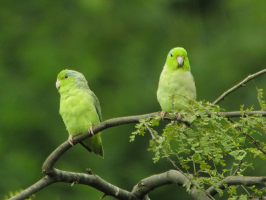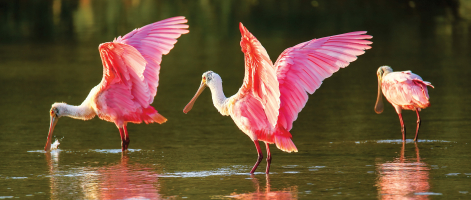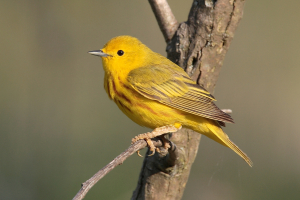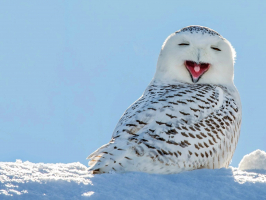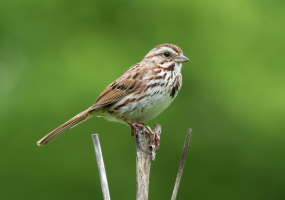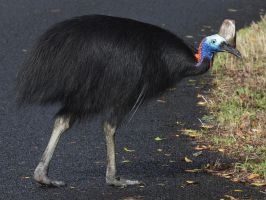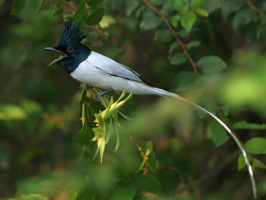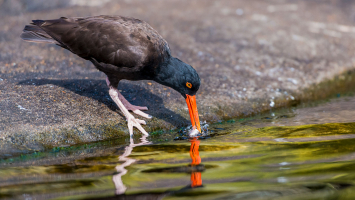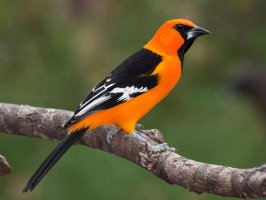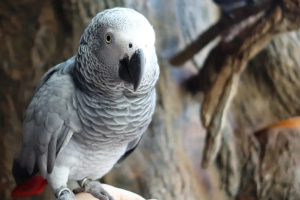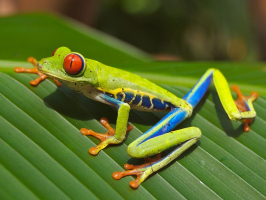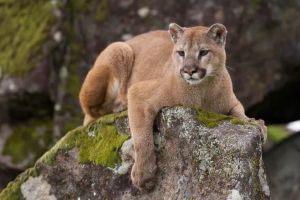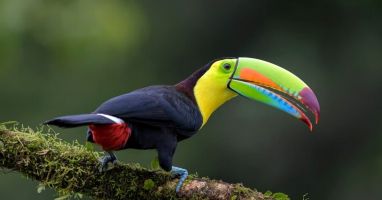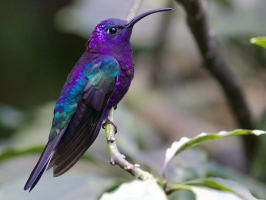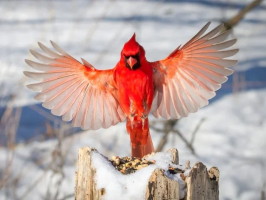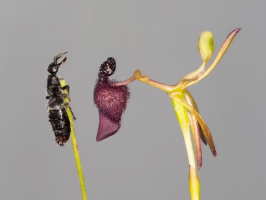Top 10 World's Beautiful Grey Birds
The feathers of grey-colored birds are very attractive, despite the fact that for many people they may seem monotonous. The majority of bird species groups ... read more...have birds of this color, such as gnatcatchers, thrushes, vireos, chickadees, nuthatches, and so on. Some birds can be seen throughout the year, while others come only in summer and some only in winter. Below is a list of the most beautiful grey birds in the world, let's find out!
-
The Tufted Titmouse (Baeolophus bicolor) is a small songbird from North America, a species in the tit and chickadee family (Paridae). Its natural habitat includes shrublands, gardens, parks, and mixed and deciduous woodlands. The tufted titmouse is a non-migratory bird that was once found only in the Ohio and Mississippi River basins. However, due to causes like bird feeders, it has expanded its range across the United States and into Ontario and Quebec in Canada. The species' distribution has been moving further north during the second part of the 20th century and into the 21st.
These tiny birds have a front that is white and a body that is grey with rust-colored flanks, measuring around six inches (15 cm) in length. They also have a tufted grey crest on their heads, as well as black foreheads. The black forehead is noticeably lessened in youngsters, making them easily mistaken for oak titmice. In general, males are bigger than females.
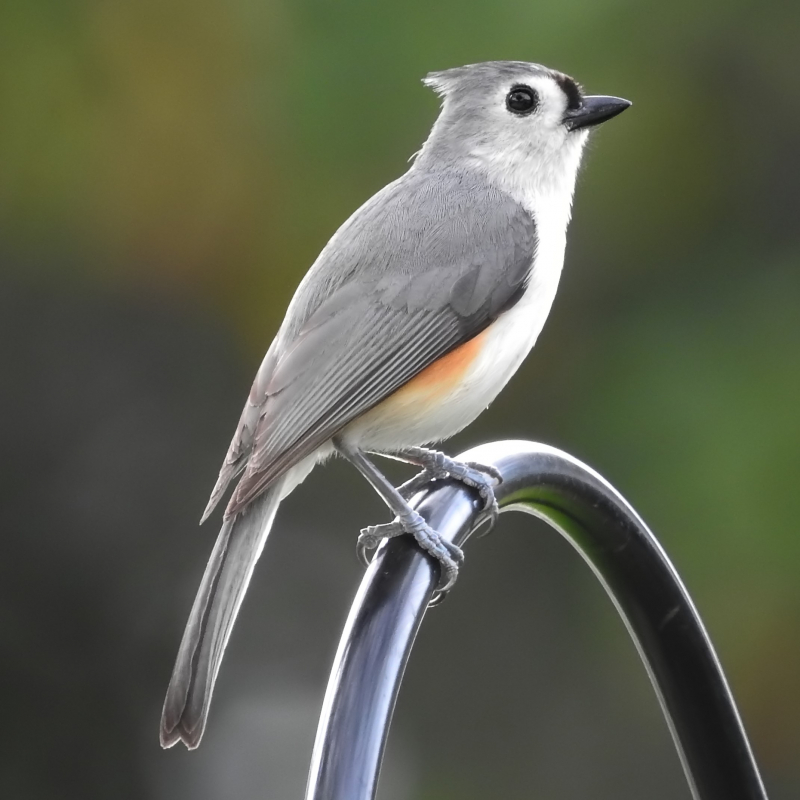
Wikipedia 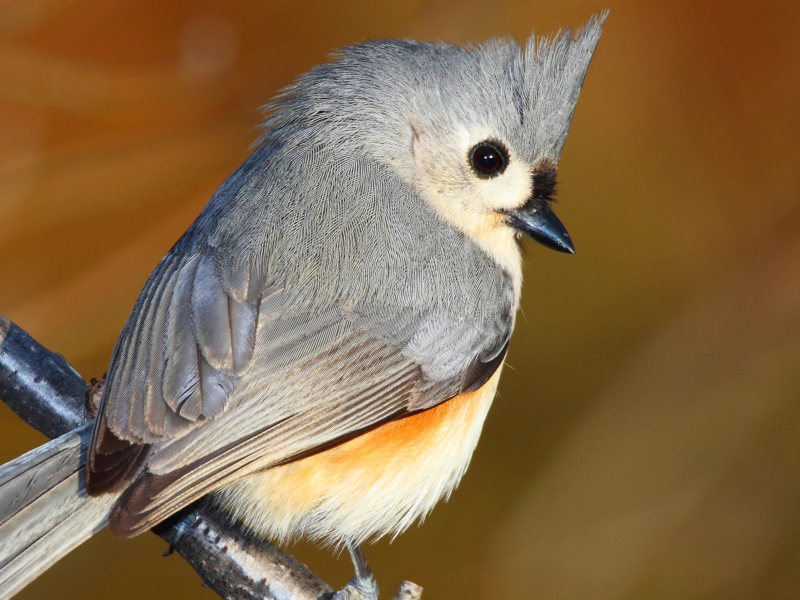
National Geographic -
The Gray Vireo (Vireo vicinior) is a small North American passerine bird. It breeds from the southwestern United States and northern Baja California to western Texas. It is a migrating species that spend the winters in southwest Texas' Big Bend National Park, western Sonora State, and the southern Baja Peninsula in Baja California Sur. In its Mexican breeding grounds, it is typically located between 1,300 and 8,200 feet (400 to 2,500 meters) above sea level. This vireo frequents the juniper on the slopes of the southwest Alps, which is dry scrub.
The gray vireo is a 14 cm long bird with a dull white underside and gray upper parts. It has an eye ring and one very thin wing bar. Its short, thick bill is present. The sexes are similar. One of a kind among vireos, its tail twitches sideways and resembles a gnatcatcher's. It feeds mainly on insects, and birds that overwinter in Mexico additionally consume fruit.
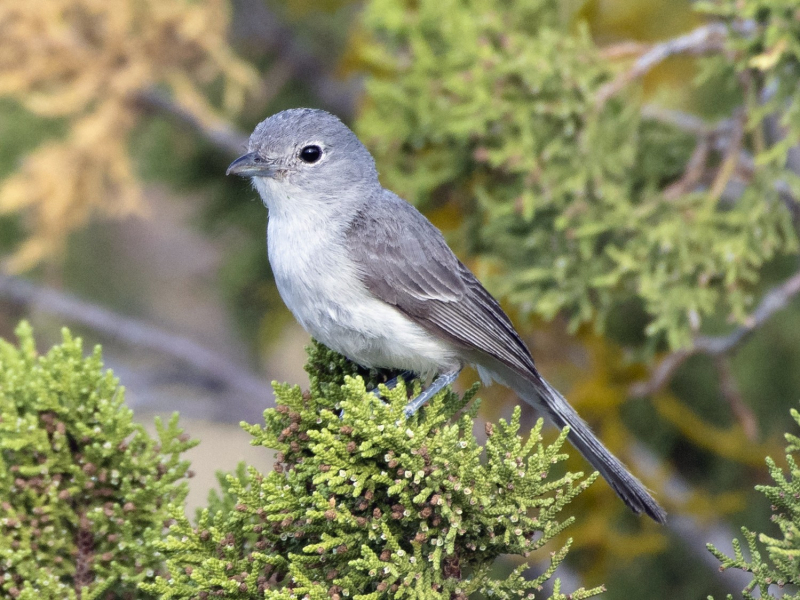
eBird 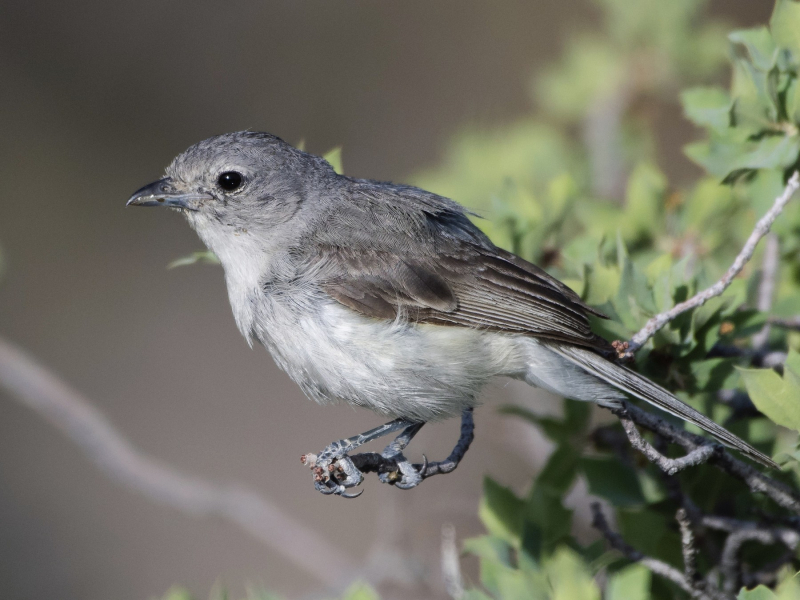
eBird -
The Carolina Chickadee (Poecile carolinensis) is a small passerine bird in the tit family Paridae. In the United States, they can be found breeding in mixed or deciduous woods from New Jersey west to southern Kansas and south to Florida and Texas. There is a gap in their range at high altitudes in the Appalachian Mountains, where they are replaced by their otherwise more northern relative, the black-capped chickadee.
Adults have a black cap and bib with white sides to the face and are 11.5–13 cm in length and 9–12 g in weight. Their back is grey, and their underparts are white with reddish brown on the flanks. They have short wings, a short dark bill, and a medium-length tail. The Carolina chickadee and the black-capped chickadee are quite similar, but the Carolina chickadee can be differentiated by its somewhat browner wings, which have brown larger coverts rather than whitish fringes, and its tail, which is also significantly shorter and more square-ended.
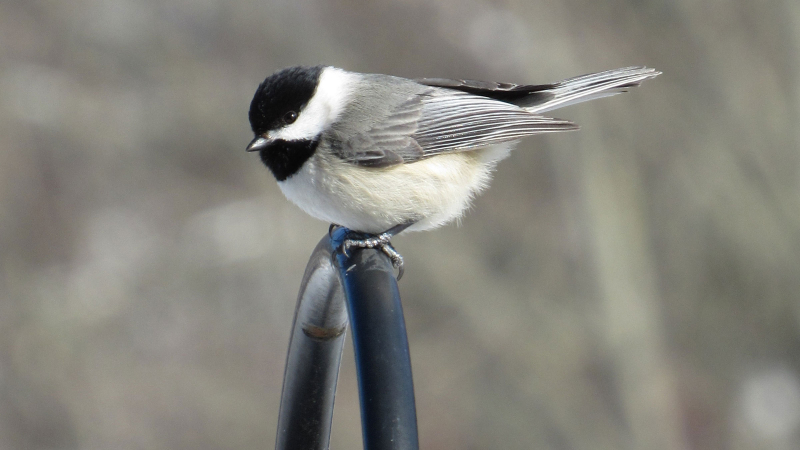
National Audubon Society 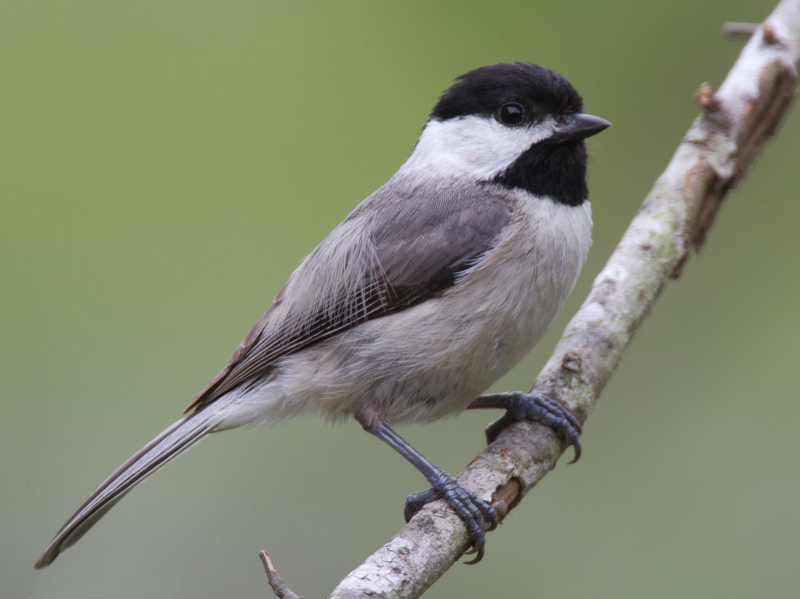
Wikipedia -
The Black-Tailed Gnatcatcher (Polioptila melanura) is a small, insectivorous bird that ranges throughout the Sonoran and Chihuahuan Deserts of the southwestern United States and northern Mexico. It is nonmigratory and found in arid desert areas year-round.
The black-tailed gnatcatcher has a length of 4.5 to 5 inches, most of which is taken up by a long tail that is black with white outer feathers. Although it resembles the blue-grey gnatcatcher in appearance and has white underparts, the amount of black in the tail feathers distinguishes the two species. The male wears a black cap that covers his eyes in the summer. Without the black cap, females and winter males are difficult to identify from the blue-grey gnatcatcher. The tail of the blue-grey is generally white when viewed from below, whereas that of the black-tailed is primarily black. This makes it easy to distinguish between the two.
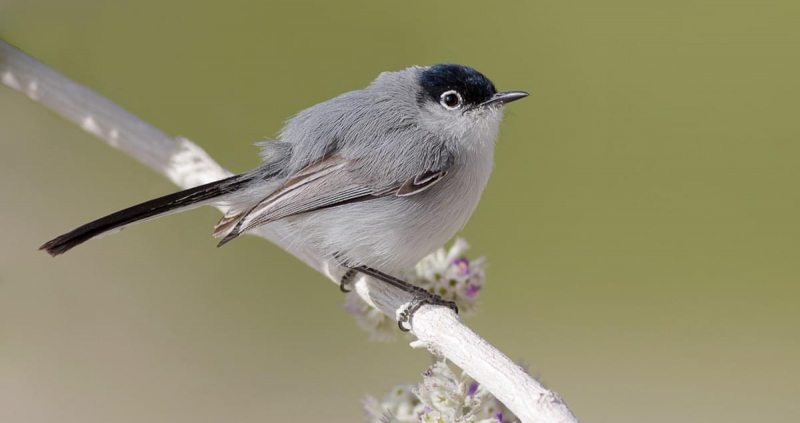
All About Birds 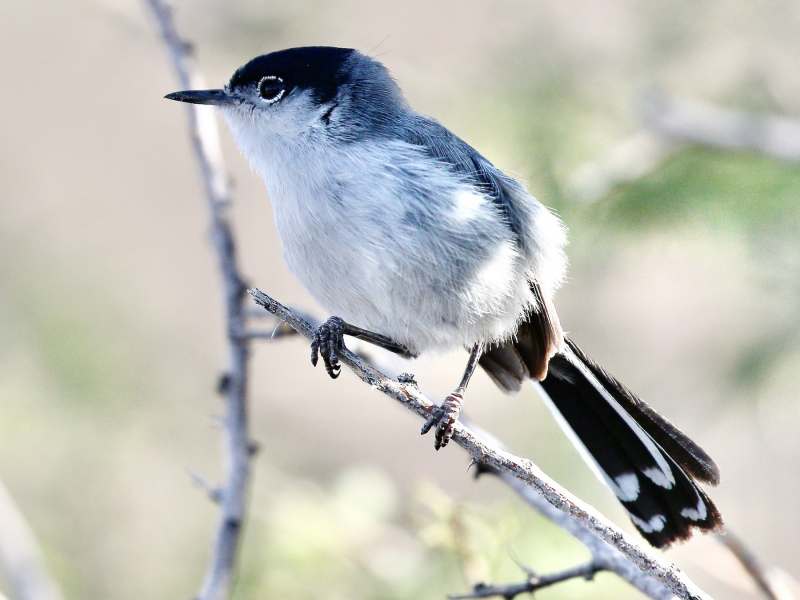
eBird -
The Gray Hawk (Buteo plagiatus) or Mexican goshawk is a smallish raptor found in open country and forest edges. It's occasionally classified as Asturina plagiata in the Asturina genus. The American Ornithological Society (AOU) separated the species from the gray-lined hawk. It is found from Costa Rica north into the southwestern United States.
The typical weight of a gray hawk is 475 g and its length ranges from 46 to 61 cm. The adult's body is a light gray color, its tail has three white bands running through it, and its legs are orange. Its upper portions are a uniform, plain gray. Birds that are still developing have dark brown upperparts, a pale-banded brown tail, brown-spotted white underparts, and a buff head and neck with brown streaking. This species is quite short-winged and has a fast agile flight for a Buteo. The call is a shrill whistled kleee-ooo.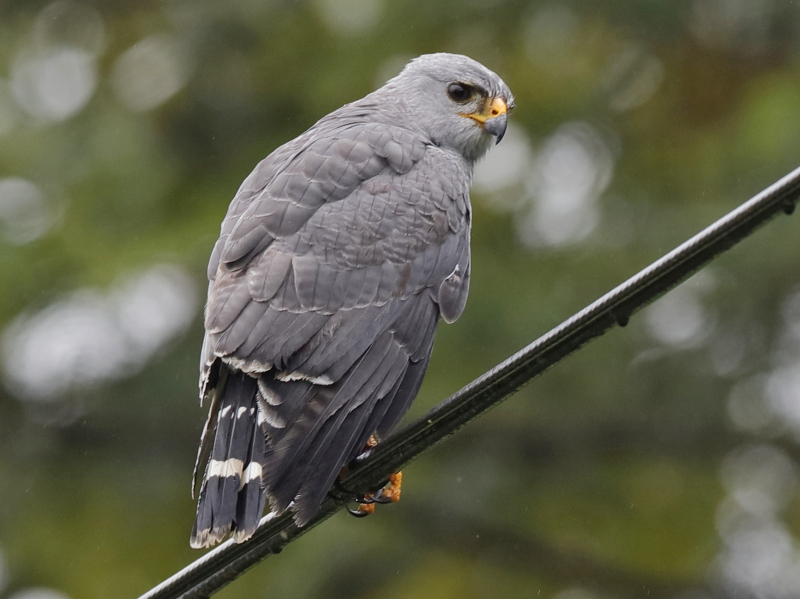
eBird 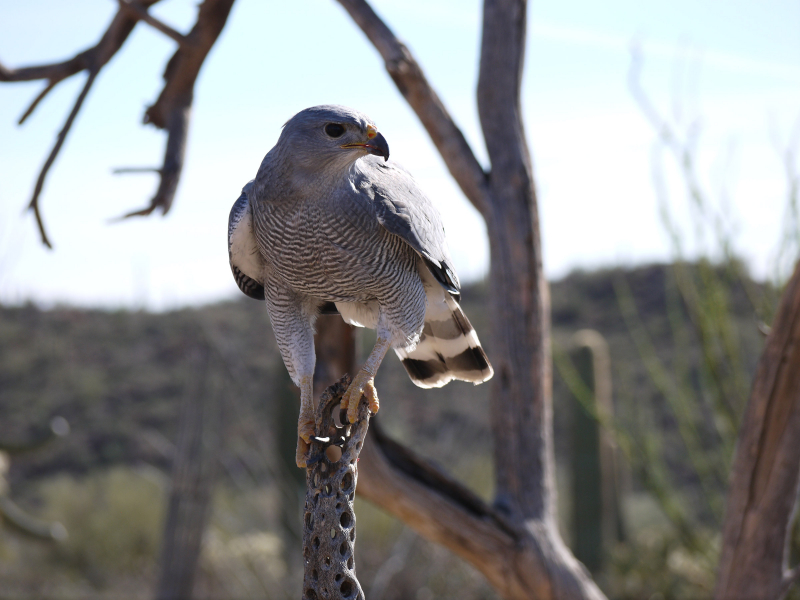
National Audubon Society -
The Northern Mockingbird (Mimus polyglottos) is a mockingbird commonly found in North America. This bird is mainly a permanent resident, but northern birds may move south during harsh weather. This species has rarely been observed in Europe. This species was first described by Carl Linnaeus in his 1758 10th edition of Systema Naturae as Turdus polyglottos.
The northern mockingbird is a medium-sized mimid with long legs and a tail. Males and females have similar appearances. Its underparts are white or whitish-gray in hue, while its upper parts are gray. It has parallel wing bars on the side of the wings linked near the white spot, giving it a striking appearance in flight. The usual white lateral rectrices and the black central rectrices are also visible in flight. The iris is typically yellow or light green-yellow, though there have been occasions where it has been orange. The bill is black with a base that seems brownish black. The juvenile appearance is defined by the streaks on the back, the distinct markings and streaks on the breast, and the gray or grayish-green color of the iris.
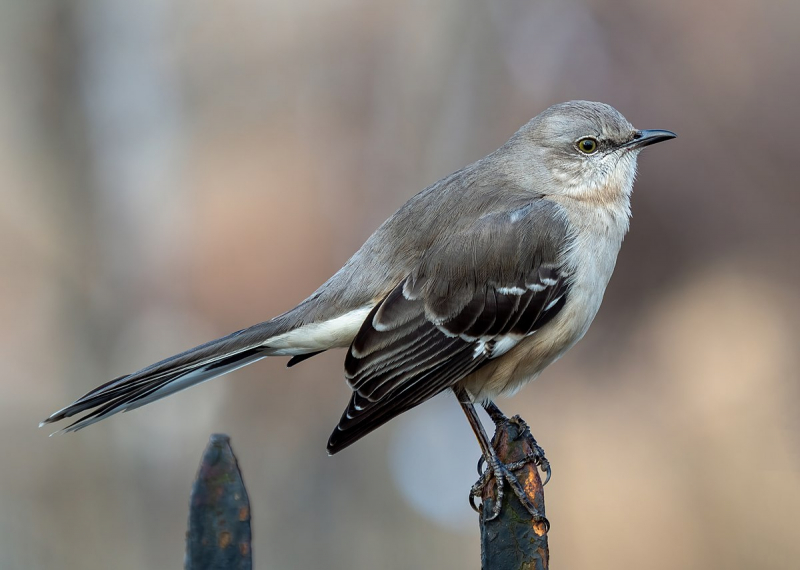
Wikipedia 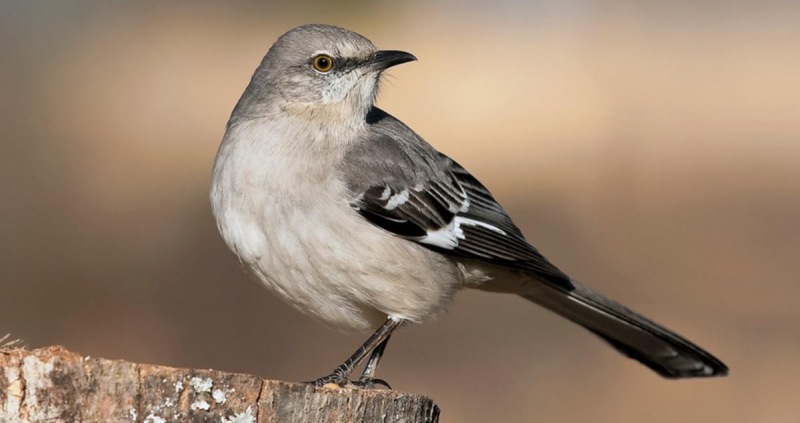
All About Birds -
Clark's Nutcracker (Nucifraga columbiana), sometimes referred to as Clark's crow or woodpecker crow is a passerine bird in the family Corvidae, native to the mountains of western North America. It is an omnivore but mostly consumes pine nuts, burying the seeds in the summer and retrieving them by memory in the winter.
The average length of a Nucifraga columbiana is 28.8 cm. It is a little bit smaller than its spotted nutcracker sibling from Eurasia (N. caryocatactes). Ashy-grey and loose in texture, the majority of its body is covered in feathers. Black and white make up the wings and tail. The outer tail feathers are white while the inner ones are black. Additionally black are the bill, legs, and feet. Long, robust, and cone-shaped describe the bill. The voice of this bird is extremely varied and produces many different sounds. However, the most frequent call is commonly described as khraaaah-khraaaah.
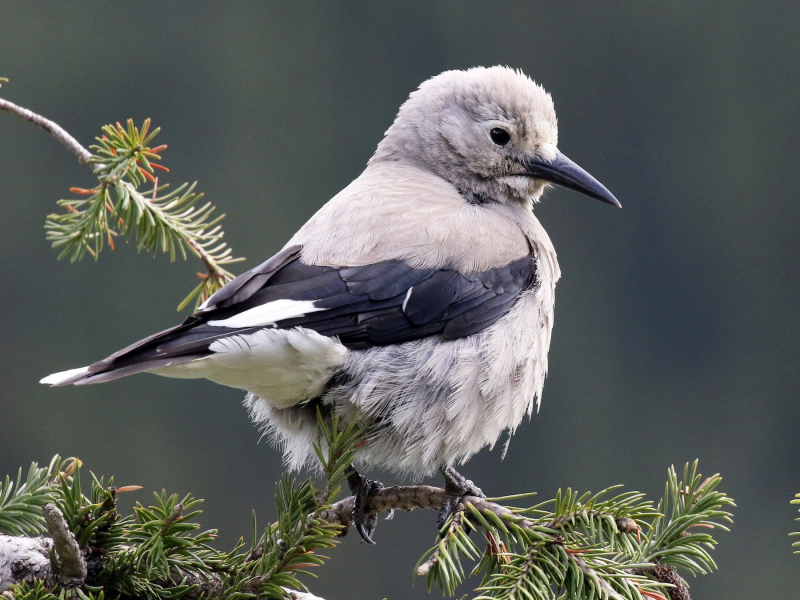
eBird 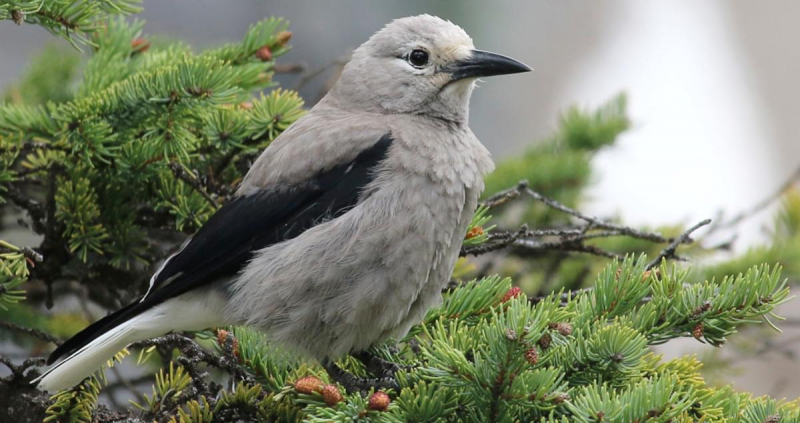
All About Birds -
The American Gray Flycatcher, or gray flycatcher (Empidonax wrightii) as it is known in North America, is a small, insectivorous passerine in the tyrant flycatcher family. It is widespread in western North America's arid regions, particularly the Great Basin. This flycatcher forages hunts insects from shrubs or low tree branches in sagebrush steppes, pinyon-juniper woods, and ponderosa pine forests.
Despite being small, American gray flycatchers are larger than the majority of Empidonax flycatchers. A normal adult is 15 cm long, with a wingspan of 22 cm, and weighs 12.5 g. Adults have light gray upper parts with darker wings and a tail that has a slight olive hue. In fresh plumage, the underparts are pale but with a faint golden wash. They have a subtle white eye ring and white wing bars. Above the base of the bill, there is a pale supraloral band. The American gray flycatcher differs from other Empidonax species in North America in that it has a long, narrow bill, a long tail, and a mandible that tends to be paler along more of its length.
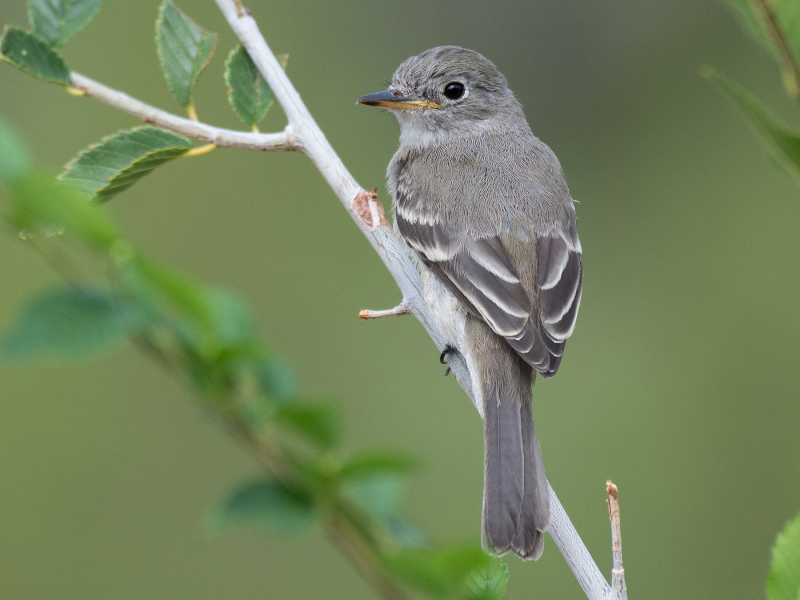
eBird 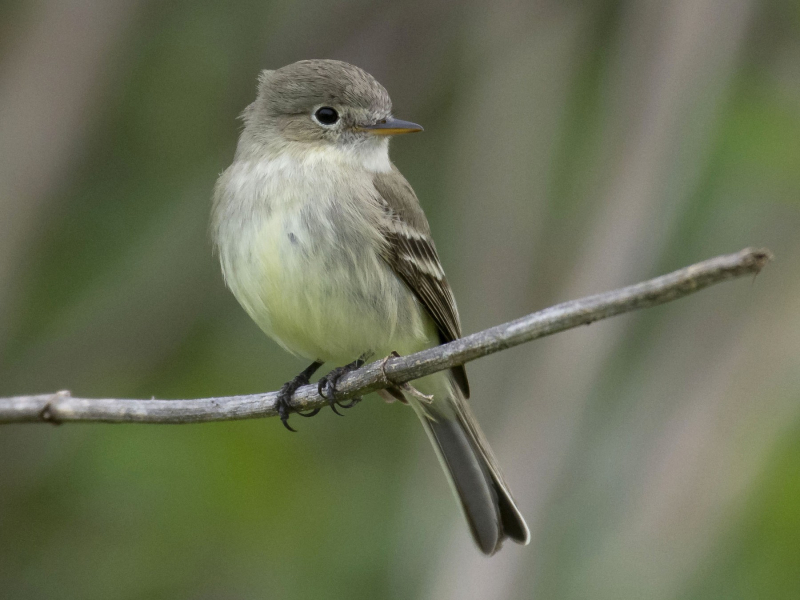
eBird -
The Sandhill Crane (Antigone canadensis) is a species of large crane of North America and extreme northeastern Siberia. The common name of this bird refers to a habitat like that at the Platte River, on the edge of Nebraska's Sandhills on the American Great Plains. This is the most important stopover area for the nominotypical subspecies, the lesser sandhill crane (A. c. canadensis), with up to 450,000 of these birds migrating through annually.
Adults are generally gray; however, when breeding, their plumage is frequently heavily soiled and tattered, especially in migratory groups, and appears almost ochre. With a range of 2.7 to 6.7 kg across the subspecies, the average weight of the larger males is 4.57 kg, whilst the average weight of the females is 4.02 kg. Sandhill cranes have a long, black, pointed beak, white cheeks, and red foreheads. Their long, dark legs trail behind them as they fly, and their long necks maintain a straight posture. Reddish-brown upperparts and gray underparts are characteristics of young birds. Both sexes have similar physical characteristics.
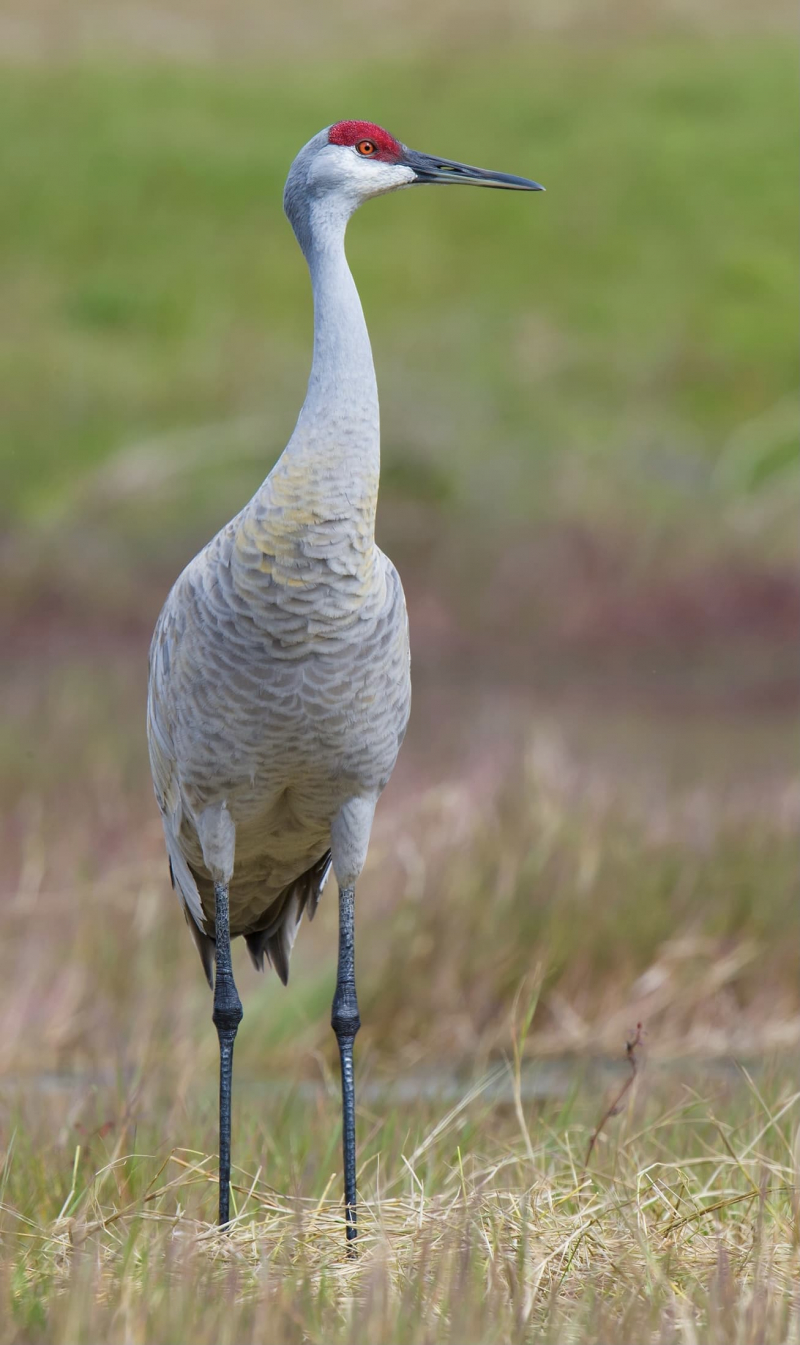
Shanghai Birding 上海观鸟 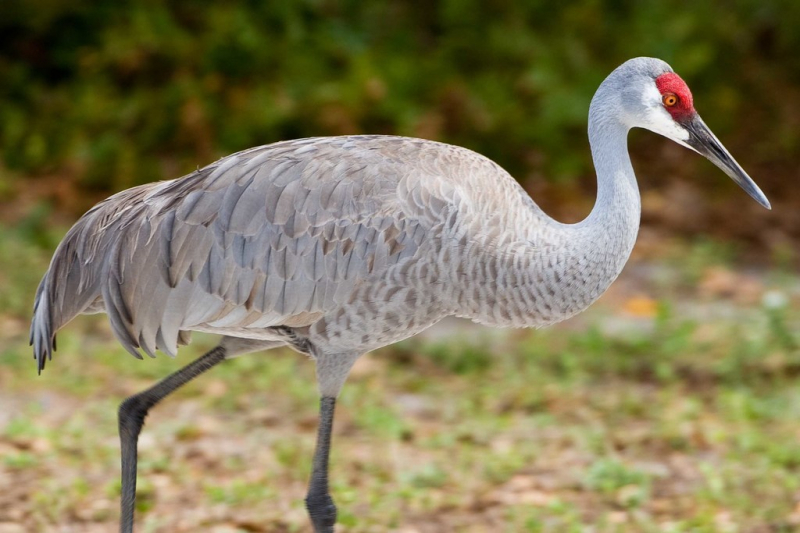
iNaturalist -
The Great Grey Owl (Strix nebulosa) (also great gray owl in American English) is a very large owl, documented as the world's largest species of owl by length. The only species of Strix to be found in both the Eastern and Western Hemispheres, it is widespread throughout the Northern Hemisphere. In some areas, it is also called Phantom of the North, cinereous owl, spectral owl, Lapland owl, spruce owl, bearded owl, and sooty owl.
Adults have broad, rounded heads, grey faces, and yellow eyes that have darker circles surrounding them. The upper parts are grey with pale bars, whereas the underparts are light with dark streaks. This owl has the largest face disc of any raptor and no ear tufts. Just below the beak, there is a white collar or "bow-tie". The lengthy tail gradually rounds off.
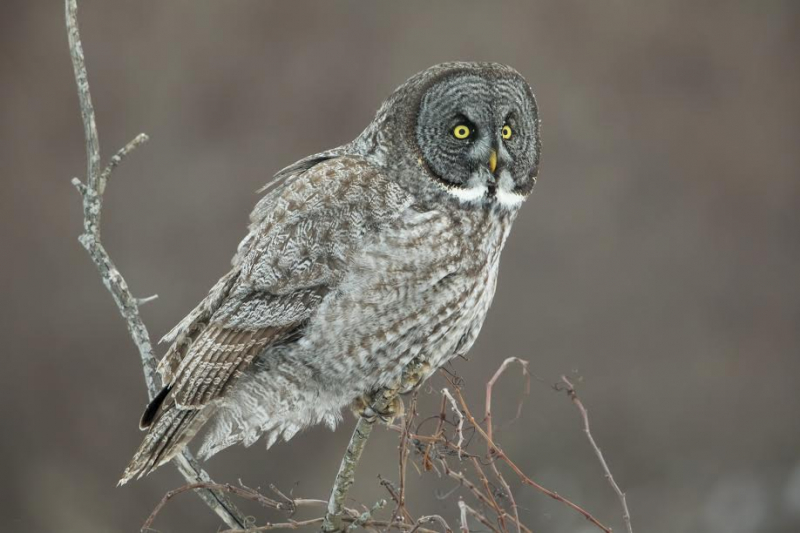
The Adirondack Almanack 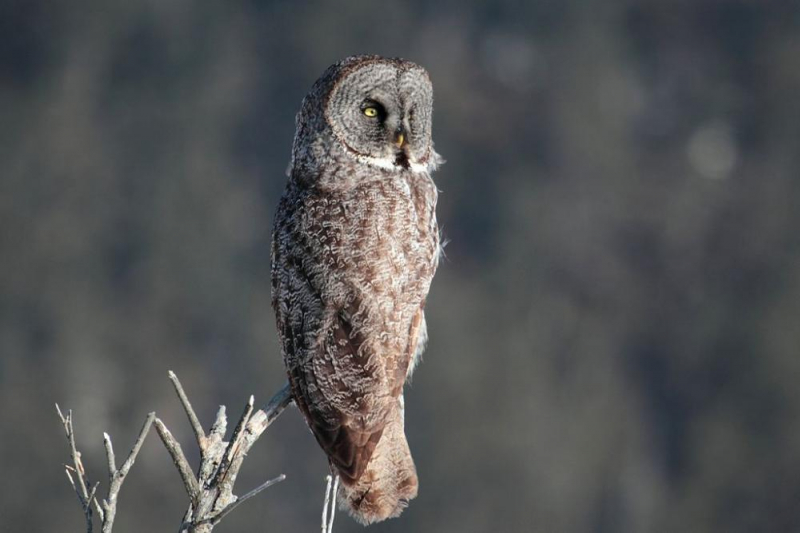
Boreal Songbird Initiative












